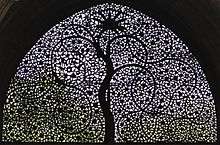Sidi Saiyyed Mosque

The Sidi Saiyyed Mosque (સિદી સૈયદ નું મસ્જિદ), more popularly known as Sidi Saiyyed Ni Jaali (સિદી સૈયદ ની જાળી), built in 1573, is one of the most famous mosques of Ahmedabad. As attested by the marble tablet fixed on the wall of the mosque, it was built by Sidi Saeed or Sidi Saiyyed, an Abyssinian in the retinue of Bilal Jhajar Khan, general in the army of the last Sultan Shams-ud-Din Muzaffar Shah III of the Gujarat Sultanate.[1]
The mosque was built in the last year of the existence of Sultanate of Gujarat.[1] The mosque is entirely arcuated and is famous for beautifully carved ten stone latticework windows (jalis) on the side and rear arches. The rear wall is filled with square stone pierced panels in geometrical designs. The two bays flanking the central aisle have reticulated stone slabs carved in designs of intertwined trees and foliage and a palm motif. This intricately carved lattice stone window is the Sidi Saiyyed Jali, the unofficial symbol of city of Ahmedabad and the inspiration for the design of the logo of the Indian Institute of Management Ahmedabad.
The central window arch of the mosque, where one would expect to see another intricate jali, is instead walled with stone.[2] This is possibly because the mosque was not completed according to plan before the Mughals invaded Gujarat.[2]
Gallery
| Sidi Saiyyed Mosque | ||||
|---|---|---|---|---|
|
References
| Wikimedia Commons has media related to Sidi Saiyyed Mosque. |
- 1 2 Nawrath, E. A. (1956). Immortal India; 12 colour and 106 photographic reproductions of natural beauty spots, monuments of India's past glory, beautiful temples, magnificent tombs and mosques, scenic grandeur and picturesque cities, ancient and modern. Bombay, Taraporevala's Treasure House of Books.
- 1 2 Khan, KDL (June 4, 2011). "The Symbol of Ahmedabad". Navhind Times. Retrieved July 1, 2011.
Coordinates: 23°01′37″N 72°34′52″E / 23.02694°N 72.58111°E

